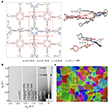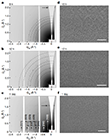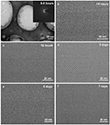New guidelines for the design of 2D polymer architectures investigated with TEM
May 08, 2024 - 2D crystals are often required to be processed into films, which are inevitably polycrystalline and contain numerous grain boundaries, and therefore are brittle and fragile, hindering application in flexible electronics, optoelectronics and separation. A team of scientists from the Sun Yat-sen and Guangdong University and research institutions in China and Universities in Dresden, Ulm and Bielefeld in Germany has reported a method to produce highly strong, tough and elastic films of an emerging class of 2D crystals.
The properties of polycrystalline materials are often characterized by defects [1]. Two-dimensional (2D) materials or polymers can be strong or tough, but rarely both, and when they are highly crystalline, they are normally with holes and defects [2]. The 2D crystals often have to be processed into thin films, which are inevitably polycrystalline and contain numerous grain boundaries [3] and are therefore brittle and fragile, which prevents the application in flexible electronics, optoelectronics and separation [4]. Moreover, similar to glass, wood and plastics, they suffer from a trade-off effect between mechanical strength and toughness [5, 6]. For the thin films, it is also important to lower the acceleration voltages from 300 and 200 kV to the optimized acceleration voltage of 120 kV to achieve contrast enhancement and gain new insights into defects [7]. The investigation at 120 kV also enabled the structure elucidation of amorphous 2D organic materials and the quantitative image to gain a detailed understanding of the molecular design of amorphous polymers for the first time [8]. The current work reported from Yang et al. shows a method for preparing high-strength, tough, and elastic films of a new class of 2D crystals—2D covalent organic frameworks (COFs) consisting of single-crystal domains connected by grain boundaries on the water surface.
Two-dimensional (2D) covalent organic frameworks (COFs) are periodic and porous 2D polymers constructed from organic nodes and linkers through covalent linkage [9]. They are typically obtained as unprocessable powders from solution synthesis [9], partially crystalline sheets from exfoliation of synthesized powders [10], discontinuous films on crystalline metal surfaces from on-surface synthesis and chemical vapor deposition [11], and partially crystalline films with crystalline domains separated by amorphous materials from interfacial synthesis [12]. Recently, polycrystalline films have been obtained by surfactants of either a small molecule or linear polymer-assisted synthesis method on water surface [13, 14]; films with larger single-crystal domains were obtained in the latter case. Nevertheless, all the films were fragile and ruptured easily, and their cracks propagated seriously along grain boundaries under pressure [3]. By contrast, amorphous materials formed by entanglement of linear polymers prevent crack propagation and exhibit tough, and even elastic, mechanical properties [15].
The authors started with 2D COF-1, which was formed by condensation of 5,10,15,20-tetrakis(4-aminophenyl)-21H,23H-porphyrin (node) with 2,5-dihydroxyterephthalaldehyde (linker 1) (Fig. 1a). For the synthesis, diethylenetriamine was added to water as a go-between, polyacrylic acid was spread onto the water surface to promote the accumulation and assembly of node protonated with p-toluenesulfonic acid through static and hydrogen interactions, and then linker 1 was added to the water to trigger the polymerization and crystallization process (Fig. 1b).
Here, the authors present the use of linear small molecules as sacrificial go-betweens to guide the polymerization and crystallization of 2D COFs to create highly crystalline yet elastic thin films on water surface. Imine-linked 2D COFs were chosen because of the high reversibility of the imine bond in water, as well as the high chemical stability of the produced COFs. Aliphatic bi-amines were used as go-betweens because they have higher reactivity but a much lower reaction constant than the aromatic quad-amine node for polymerization with aldehyde linker [16], and can form linear chains with the linker to facilitate entanglement of adjacent domains of COFs at the grain boundary, and subsequent replacement by the node. Polyacrylic acid was selected as the polymer surfactant to assist the interfacial synthesis. The polymerization and crystallization process was monitored and the mechanical properties of the 2D COF film were analyzed with both nanoindentation and the bulge test.
Next, the authors checked the long-range order and microscopic structure of the film. Several sharp grazing incidence wide-angle X-ray scattering (GIWAXS) reflections in both in-plane and out-of-plane directions indicated the high overall crystallinity of the film over several square centimeters (Fig. 2b). The in-plane reflections were well indexed and offered the film a simple tetragonal lattice with a = 2.54 nm. It also supported the in-plane periodicity of the simulated interwoven structure. Clear out-of-plane reflection at roughly 1.59 Å−1 and 2.03 Å−1 occurred, which gave an interlayer distance of about 3.95 Å and 3.09 Å, respectively. The former one was attributed to π–π stacking distance between adjacent layers in 2D COF-1 [14]. The latter one was thinner than a single carbon layer (0.335 nm) [17], and was attributed to the interwoven structure because the distances between adjacent linkers and between adjacent nodes in the vertical direction are approximately 3.12 Å and 3.14 Å (Fig. 2a). An interwoven structure typically exists in crystals possessing such structures intrinsically; it also presents in amorphous polymeric materials owing to the entanglement of their linear chains, but has not been realized as a grain boundary so far [15, 18]. The interwoven grain boundary leads to the whole film being regarded as a continuous film through both covalent linkage and non-covalent interactions simultaneously, suggesting high mechanical strength, toughness, and elasticity. Stitched aberration-corrected high-resolution transmission electron microscopy (AC-HRTEM) images over 40 μm2 of a randomly selected area of the film indicated that it was composed of single crystalline domains, as pointed out by Fourier filtering (Fig. 2c).
To gain an insight into the mechanism for the formation of the film, the polymerization and crystallization process was monitored. A clear out-of-plane interlayer distance of about 3.09 Å occurred at 8 h (Fig. 3a). With the prolongation of reaction time, the intensity of reflections increased, suggesting that the overall crystallinity of the film increased gradually. At 12–16 h, several strong reflection rings occurred, indicating that the domains had different in-plane and out-of-plane orientations (Fig. 3c). At 1 day, vertical reflection corresponding only to the interlayer distance of 3.95 Å remained (Fig. 3c). The gradual change of the interlayer distance indicated that there was a rearrangement of orientation of different domains and different layers during the polymerization and crystallization process. AC-HRTEM offered a microscopic view of the reorientation of different domains, the gradual increase of the single-crystal domain size, and the decrease of the number of grain boundaries (Fig. 3d–f and Fig. 4a–f).
Here, the authors developed a sacrificial go-between guided interfacial synthesis method to introduce an interwoven structure (which typically exists in amorphous linear polymers) into imine-linked polycrystalline films of 2D COFs to connect their single-crystal domains, thereby endowing them with high strength, toughness, and elasticity. Toughness and elasticity are typical mechanical properties of amorphous linear polymers, rather than of films of 2D COFs composed of single-crystal domains. The authors used imine-linked 2D COFs to introduce the structure and property of amorphous materials into the crystals; it is likely that the structures and properties of amorphous materials can also be applied to other crystalline materials, endowing them with new properties, enhancing their specific applications, and paving the way for new applications.
Resource: Yang, Y., Liang, B., Kreie, J., Hambsch, M., Liang, Z., Wang, C., Huang, S., Dong, X., Gong, L., Liang, C., Lou, D., Zhou, Z., Lu, J., Yang, Y., Zhuang, X., Qi, H., Kaiser, U., Mannsfeld, S. C. B., Liu, W., Gölzhäuser, A., & Zheng, Z. (2024). Elastic films of single-crystal two-dimensional covalent organic frameworks. Nature, 630, 878-883. https://doi.org/10.1038/s41586-024-07505-x
Qi, H., Liang, B., & Kaiser, U. Perspective towards atomic‐resolution imaging of two‐dimensional polymers. SmartMat, 2(2), 131-138 (2021). https://doi.org/10.1002/smm2.1035
-
Wei, Y., Wu, J., Yin, H., Shi, X., Yang, R., & Dresselhaus, M. (2012). The nature of strength enhancement and weakening by pentagon–heptagon defects in graphene. Nature Materials, 11(9), 759-763. https://doi.org/10.1038/nmat3370
-
Qi, H., Sahabudeen, H., Liang, B., Položij, M., Addicoat, M. A., Gorelik, T. E., Hambsch, M., Mundszinger, M., Park, S., Lotsch, B. V., Mannsfeld, S. C. B., Zheng, Z., & Kaiser, U. Near–atomic-scale observation of grain boundaries in a layer-stacked two-dimensional polymer. Science Advances, 6(33), eabb5976 (2020). https://doi.org/10.1126/sciadv.abb5976
-
Wei, C., Li, L., Zheng, Y., Wang, L., Ma, J., Xu, M., Lin, J., Xie, L., Naumov, P., Ding, X., Feng, Q., & Huang, W. Flexible molecular crystals for optoelectronic applications. Chemical Society Reviews, 53, 3687-3713 (2024). https://doi.org/10.1039/D4CS00125A
-
Ritchie, R. O. The conflicts between strength and toughness. Nature Materials, 10(11), 817-822 (2011). https://doi.org/10.1038/nmat3115
-
Galeski, A. Strength and toughness of crystalline polymer systems. Progress in Polymer Science, 28(12), 1643-1699 (2003). https://doi.org/10.1016/j.progpolymsci.2003.09.001
-
Liang, B., Zhang, Y., Leist, C., Ou, Z., Položij, M., Wang, Z., Mucke, D., Dong, R., Zheng, Z., Heine, T., Feng, X., Kaiser, U., & Qi, H. Optimal acceleration voltage for near-atomic resolution imaging of layer-stacked 2D polymer thin films. Nature Communications, 13(1), 1-9 (2022). https://doi.org/10.1038/s41467-022-30091-0
-
Liang, B. Condition-Optimized AC-HRTEM Characterization of Beam-Sensitive 2D Organic Frameworks. Doctoral dissertation, University Ulm, pp. 189 (2023).
-
Evans, A. M., Parent, L. R., Flanders, N. C., Bisbey, R. P., Vitaku, E., Kirschner, M. S., Schaller, R. D., Chen, L. X., Gianeschi, N. C., & Dichtel, W. R. Seeded growth of single-crystal two-dimensional covalent organic frameworks. Science, 361(6397), 52-57 (2018). https://doi.org/10.1126/science.aas9275
-
Wang, S., Wang, Q., Shao, P., Han, Y., Gao, X., Ma, L., Yuan, S., Ma, X., Zhou, J., Feng, X., & Wang, B. Exfoliation of covalent organic frameworks into few-layer redox-active nanosheets as cathode materials for lithium-ion batteries. Journal of the American Chemical Society, 139(12), 4258-4261 (2017). https://doi.org/10.1021/jacs.7b00544
-
Liu, W., Luo, X., Bao, Y., Liu, Y. P., Ning, G. H., Abdelwahab, I., Li, L., Nai, C. T., Hu, Z. G., Zhao, D., Liu, B., Querk, S. Y., & Loh, K. P. A two-dimensional conjugated aromatic polymer via C–C coupling reaction. Nature Chemistry, 9(6), 563-570 (2017). https://doi.org/10.1038/nchem.2713
-
Liu, K., Qi, H., Dong, R., Shivhare, R., Addicoat, M., Zhang, T., Sahabudeen, H., Heine, T., Mannsfeld, S., Kaiser, U., Zheng, Z., & Feng, X. On-water surface synthesis of crystalline, few-layer two-dimensional polymers assisted by surfactant monolayers. Nature Chemistry, 11(11), 994-1000 (2019). https://doi.org/10.1038/s41557-019-0332-2
-
Ou, Z., Liang, Z., Dong, X., Tan, F., Gong, L., Zhao, P., Wang, H., Liu, W., & Zheng, Z. Surfactants Mediated Synthesis of Highly Crystalline Thin Films of Imine‐Linked Covalent Organic Frameworks on Water Surface. Chinese Journal of Chemistry, 39(12), 3322-3328 (2021). https://doi.org/10.1002/cjoc.202100402
-
Ou, Z., Liang, B., Liang, Z., Tan, F., Dong, X., Gong, L., Zhao, P., Wang, H., Zou, Y., Xia, Y., Chen, X., Liu, W., Qi, W., Kaiser, U., & Zheng, Z. Oriented growth of thin films of covalent organic frameworks with large single-crystalline domains on the water surface. Journal of the American Chemical Society, 144(7), 3233-3241 (2022). https://doi.org/10.1021/jacs.1c12244
-
Wang, L., Wang, B., Wang, Z., Huang, J., Li, K., Liu, S., Lu, J., Han, Z., Gao, Y., Cai, G., Liu, Y., Chen, Y., Lin, Y., Liu, Y., Gao, C., & Xu, Z. Superior strong and tough nacre-inspired materials by interlayer entanglement. Nano Letters, 23(8), 3352-3361 (2023). https://doi.org/10.1021/acs.nanolett.3c00345
-
Yu, M., Hu, Z., Zhou, J., Lu, Y., Guo, W., & Zhang, Z. Retrieving grain boundaries in 2D materials. Small, 19(7), 2205593 (2023). https://doi.org/10.1002/smll.202205593
-
Al-Jishi, R. & Dresselhaus, G. Lattice-dynamical model for graphite. Phys. Rev. B, 26, 4514-4522 (1982). https://doi.org/10.1103/PhysRevB.26.4514
-
Liu, Y., Ma, Y., Zhao, Y., Sun, X., Gándara, F., Furukawa, H., Liu, Z., Zhu, H., Zhu, C., Suenaga, K., Oleynikov, P., Alshammari, A. S., Zhang, X., Terasaki, O., & Yaghi, O. M. Weaving of organic threads into a crystalline covalent organic framework. Science, 351(6271), 365-369 (2016). https://doi.org/10.1126/science.aad4011




